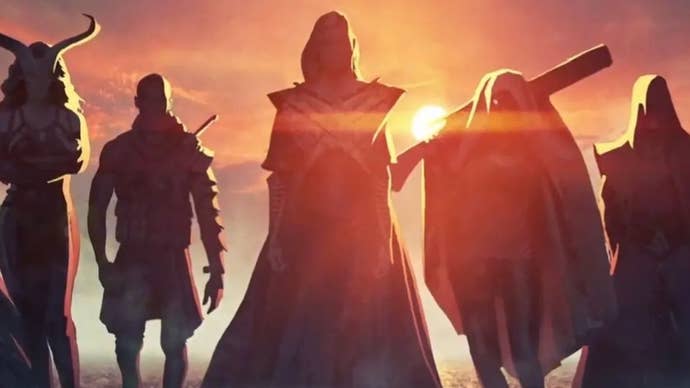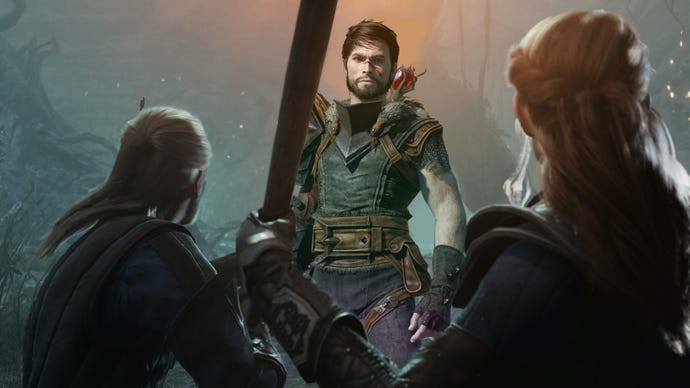Baldur’s Gate 3 benefits from the absence of Dragon Age (and how this helps Dreadwolf, too)
Many are jumping into Baldur’s Gate 3 to quench their thirst for the next Dragon Age. The result? Both IPs are winning.
It’s become quite apparent that casual players instantly connected Larian Studios’ latest game and, previously, BioWare’s beloved IP because of their colorful companions and the players’ relationships with them. That “bear trailer” might be among the biggest marketing wins of the year if we look at the post-launch numbers that Baldur's Gate 3 keeps hitting even one week after its release and before arriving on PS5 next month. We certainly can’t ignore the already-in-place CRPG community that was dying to play a worthy follow-up to BioWare’s two original games, but I’d say BG3 owes its mainstream success to a very specific fantasy RPG crowd.
This situation also feels like a truly earned “full circle” moment, given BioWare started it all (and later went off to create a Baldur’s Gate successor, of sorts), though its own take on the premise had a combat system was closer to that of Jade Empire and KOTOR. What’s funny about the first Dragon Age is that it was largely marketed as a way edgier take on the fantasy RPG formula, yet people resonated with its goofier side the most, something that slowly influenced the creative direction of the saga. By the time 2014’s Dragon Age: Inquisition launched, the property’s sharpest edges had been all but polished off.

Mind you, this doesn’t mean Dragon Age lost its hard-hitting world-building or more serious side along the way. I always found those games to be less “aesthetically hostile” as time marched on, and it was easy to see why if you paid attention to the fandom’s own evolution. What started as a “dark and cruel fantasy universe” soon became a clear alternative to Dungeons & Dragon’s Forgotten Realms setting and replicated much of its playful spirit to bring in more adventurers that perhaps had ignored video game RPGs for too long.
It's not just CRPGs that seemed “too complex” to more casual players before Baldur’s Gate 3 arrived. Two generations ago, Dragon Age – or even Mass Effect – also had to do some heavy lifting to convince potential recruits, and the whole “choose your own adventure in a cinematic way” angle that was taking off in the late 2000s clearly helped a lot. Nowadays, studios fully know that many of their games’ followers are there for the plot and the romances, so much-welcomed accessibility options are put in place. Back then, games were barely offering these olive branches to more casual gamers. But still, tons of players that hadn’t gotten into RPGs before took a leap… and soon became obsessed with BioWare’s universes. This phenomenon would also happen, years later, with the third Witcher game.

My partner, who got into both Dragon Age and Mass Effect later, exhausted all they had to offer much faster than I could’ve marathoned them. This was also true for countless players who thought RPGs were “harder to get into” than they actually were. Almost nine years after the release of the last Dragon Age, there’s clearly an appetite for Dreadwolf or any alternative that even comes close enough to the three previous games.
Of course, massive RPGs – traditional or modern – haven’t gone anywhere, but it’s hard to deny that scratching that particular Dragon Age itch has been nearly impossible, so it only made sense that Larian’s take on Baldur’s Gate would be the one project to soothe the pain that Dragon Age fans have been experiencing for the last few years. Yes, it all plays out following Dungeons & Dragons’ systems adapted into digital format (with the biggest difference being that combat is turn-based), but everything else is similar enough to instantly capture the attention of BioWare’s legions. More importantly, the right kind of mischievous spirit covers the entire game.

As good as the dungeon-delving and problem-solving sections in Baldur’s Gate 3 are, at the end of the day, many players joined the party because they wanted to create either a funny little guy or the hottest protagonist ever and then interact with the colorful cast of companions. Past the early hours of the game, the most memorable exchanges typically happen at the camp (which you can set up anywhere, somehow), something that instantly takes us back to Dragon Age: Origins’ breathers.
It's not long before most companions open up to you if you’re not a jerk. Pretty much everyone has a personal secondary questline worth following, and even if your progress on that front is slow, returning to each party member for a chat before clocking out for the day is advisable. However, one of my (very few) quibbles with Baldur’s Gate 3 is that every companion appears to be immediately “playersexual” and a bit too upfront with their intentions too early on.
The key to Dragon Age’s success when it came to romances (or simply fooling around) was that those games took their time with the many personal relationships available and often made things slightly difficult so it didn’t feel like putting coins into a slot machine. Sadly, BG3’s approach is simpler.

As common as this opinion appears to be, we appear to be in the minority. Look around and you’ll see tons of players having the time of their lives with those same moments and all the little interactions with NPCs found throughout the extensive maps, horny or not. Baldur’s Gate 3’s writing and overall design is magnificent and worth celebrating, and if I put my aforementioned nitpicks aside, I’m flabbergasted by the overall level of quality and care – from the texts themselves to the voice acting – put into an absurd number of characters, small and big. Baldur’s Gate 3, much like any D&D campaign worth remembering, is a story made up of smaller stories that are equally as memorable. Although its many intricate and flexible systems are just as important, that’s what makes it so special in my humble opinion. It’s all killer, no filler.
Looking at the future of Dragon Age, leaks seem to suggest at least Dreadwolf’s combat will be an entirely different beast which sticks closer to modern design trends. This will surely be a cause for debate among the old guard, but I can’t see the series’ biggest fans turning their backs on the fourquel they’ve been waiting for a decade as long as it hits the right notes when it comes to the cast of characters and the signature joyful spirit in the face of doom. Such fans have found an oasis in Baldur’s Gate 3, and anyone whose first D&D-like adventure is Larian’s behemoth will assuredly be looking for something similar in the near future. I have a feeling EA and BioWare will indirectly benefit from this huge win for Western RPGs.

